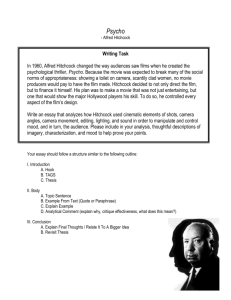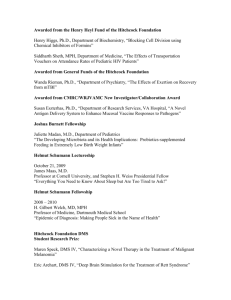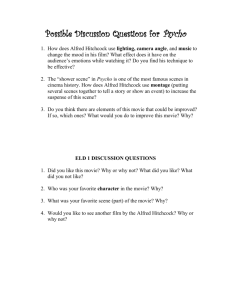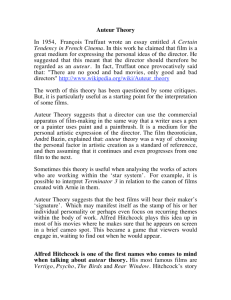Picture
advertisement
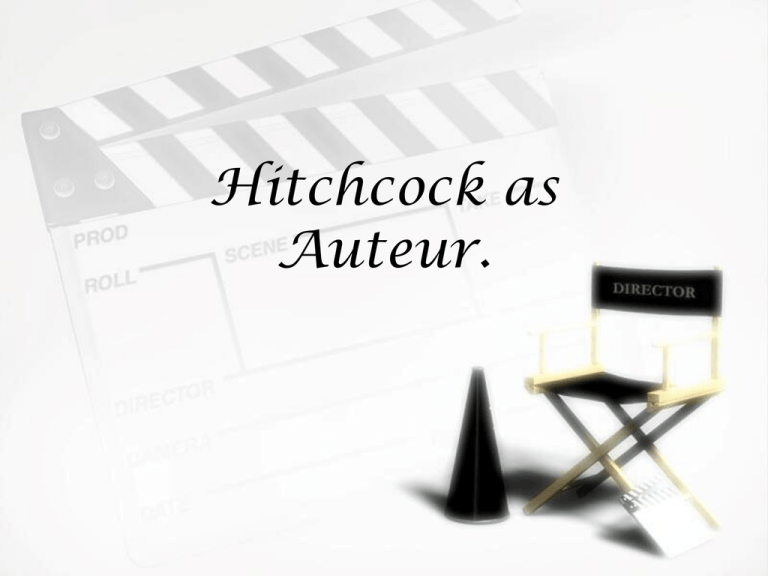
Hitchcock as Auteur. Auteur theory was articulated in the 1950’s by French film critics, most notable by Francois Truffaut. The concept describes the mark of a film director in terms of: thematic or stylistic consistencies personal aesthetic vision recurring themes established technique a defined view of the world a significant degree of control over production. (Source: Hitchcock:Auteur?-www.newspaper archive.com ) The works of an auteur director are stamped by the personality and unique artistic vision of its creator, and are as recognisable and distinctive as the creators of any other work of art. In auteur films, it is the director who controls the artistic statement, takes credit for the film and is responsible for attracting the audience. When auteur theory was being developed, Alfred Hitchcock was frequently acknowledged as the consummate examplar, and his name evokes immediate expectations in terms of themes and techniques. As befits the master of mystery and suspense, his films play with the audience’s nerves, sexually or tabooed areas assume central or implicit places in his work (the latent homosexuality of Strangers on a Train, the parody of an Oedipus complex in Psycho and the traumatic remembrance of repressed memories of Marnie) There is a persistent element of black comedy, and frequent eccentric characterisations. Hitchcock was influenced by the German Expressionists, and admired their ability “to express ideas in purely visual terms” (www.sensesofcinema.com/contents/directors) It is this visual expression of thought and psychological processes that Hitchcock achieves throughout his films. Sir Alfred Joseph Hitchcock, KBE (August 13, 1899 – April 29, 1980) was a highly influential film director and producer who pioneered many techniques in the suspense and thriller genres. He directed more than fifty feature films in a career spanning six decades, from the silent film era, through the invention of talkies, to the colour era. Hitchcock was among the most consistently successful and publicly recognizable directors in the world during his lifetime, and remains one of the best known and most popular directors of all time, famous for his expert and largely unrivalled control of pace and suspense throughout his movies. Hitchcock was born and raised in Leytonstone, London, England. While he began his directing career in London, he worked primarily in the United States beginning in 1939 and applied for U.S. citizenship in 1956. Hitchcock and his family lived in a mountaintop estate high above Scotts Valley, California, from 1940 to 1972. He died of renal failure in 1980. Hitchcock's films draw heavily on both fear and fantasy, and are known for their droll humour. They often portray innocent people caught up in circumstances beyond their control or understanding. This often involves a transference of guilt, in which the "innocent" character's failings are transferred to another character, and magnified. Rebecca was the only one of his films to win the Academy Award for Best Picture, although four others were nominated. However, Hitchcock never won an Academy Award for Best Director. He was awarded the Irving G. Thalberg Memorial Award for lifetime achievement in 1967, but never personally received an Academy Award of Merit. We will analyse the opening scene of Alfred Hitchcock’s ‘Rear Window’ to present him as an Auteur. We will now look at the first few minutes of ‘Rear Window’. Through out the presentation I will refer to certain shots so look closely and see what techniques you can see Hitchcock has used. In this scene there is no dialogue and the camera is telling the story which is known as ‘pure cinema’. Hitchcock invented and is well known for using ‘pure cinema’ in his films to create suspense. The credit sequence opens the film with window blinds being rolled up slowly. Hitchcock uses this to introduce the audience to the window and voyeurism aspect of the film and creates the effect of drawing you in. The credit sequence is accompanied by music created by a whole orchestra of sound. It creates jumpy, upbeat and light hearted music, music that personifies morning rush hour Hitchcock has a very close relationship with music in his films and feels a certain type of music can create a certain mood within a scene. He uses this music to create a busy atmosphere. The camera begins to dolly out the window. Hitchcock also uses the technique in ‘Psycho’ where the camera moves from the outside into a window of an office at a beginning of a scene: ‘A high angle cityscape, a zoom-in to and through the window, the abruptly dark room and the room lit normally, as befitting gradually adjusted vision.’ We are now looking on to a courtyard of flats. The flats seem to be in a busy spot. It seems it be foggy in the small bit of sky we can see in the distance. This can indicate the early morning. Lighting is used well here as it has to be just right to represent early morning. The camera then shows us a shot of a black cat walking up steps in the courtyard. The camera then begins to introduce us to the interior courtyard and the other flats. The camera begins to pan to the left showing the other windows but there are no people in any of the flats. This entices the viewers The camera then dollies back in the window. There is a close-up of Jefferies who seems to be asleep in a chair near the window and has sweat on his forehead. ‘The surprise disclosure of Jefferies can be seen as a lesson in viewing: from now on the spectator will be on the alert for anything important that may unpredictably come into view whenever the camera is moving.’ I think this technique of introducing Jefferies, the protagonist is original and shows the individuality of Hitchcock. There is then a shot of a thermometer that shows a very hot temperature of 93°C. This shows the reason that the man was sweaty and close to the window. The 360 degree panning movement is repeated in greater detail and introduces us to the composer. This is done solely by ‘pure cinema’. The camera then stops at a fire escape where two people trying to escape the heat by sleeping outside. The camera begins to pan south west of the balcony missing out the first flat that was shown on the first rotation of the flat windows. This adds suspense to the film because the audience are left wondering why the camera left out that particular scene. The camera pauses at a white framed window. A blond haired young woman known famously as Miss Torso is wearing shorts and a strapless bra goes about her every day routine. She could be seen as a pleasant diversion. Hitchcock uses this aspect in most of his films as he had a fixation with the sexual side of peoples viewing. The camera comes back into the flat and pauses. A sweaty man is in a wheelchair with a broken leg is in the flat. The flat is very small and cramped. Written on the cast is the name of the owner ‘L.B Jefferies’. The camera introduces us to the rest of the flat. From this scene we learn through Hitchcock’s use of ‘pure cinema’ that Jefferies is a successful photographer who has had an accident while on a job and has to stay cooped up in a small hot room with nothing to do but look out his window at the other flat windows. I will finish by looking at a conversation with Hitchcock so he can explain to us through his own words a bit of who he is.
